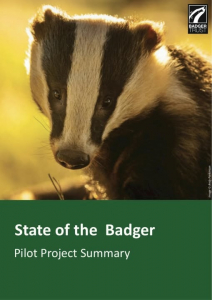State of the Badger Pilot Report
Badger Trust has released a comprehensive 70-page report on the pilot of its state of the badger initiative.
For those pressed for time, a concise 3-page summary is also available.
Understanding the pilot study.
Understanding the population health of badgers in England and Wales
A project instigated by Badger Trust. Text from Badger Trust.
The exact number of badgers in Britain is unknown, and there is an urgent need to understand the population health of Britain’s largest remaining carnivore. Badger Trust’s first-ever State of the Badger survey and the resulting State of the Badger Report will assess the current population trends for badgers in England and Wales.
While there is much analysis on badger behaviour, up-to-date and accurate data about influences on badger population levels is lacking, especially after a decade of government-endorsed badger culling, high rates of badger crime, and increased planning and development.
State of the Badger Report Aim
The aim is to produce a comprehensive report that answers some of the questions regarding badger population, threats, and recovery. The report will be used to assess density and distribution estimates, historical and current population changes, and badger crime statistics.
Crucially, it will be used to raise awareness of the plight of badgers in England and Wales through an expanded volunteer network and educational engagement with the wider public. Badger Trust will achieve this by working with a broad network of volunteers, colleges and universities, wildlife and environmental NGOs, and scientific advisors.
The successful application of this project will provide a baseline of data that would allow Badger Trust to repeat the study every five to ten years to demonstrate changing trends in badger population and welfare, whilst growing national pride for Britain’s most iconic native mammal.
Why survey badgers?
The European badger (Meles meles) is listed as “least concern” by the IUCN. The IUCN assessment of Meles meles is a habitat level analysis, covering the whole range of the Eurasian badger and not specific to Great Britain, where significant threats are present.
Overall, few studies exist that provide contemporary population estimates for European badgers in Britain, and none specific to key counties of interest (e.g. counties impacted by badger culling and heightened rates of planning and development and wildlife crime).
Although badgers are among the most legally protected British wildlife (as listed in Appendix III Of the Bern Convention and safeguarded by the Protection of Badgers Act 1992), badgers are recognised as one of the most persecuted British wildlife species. From rising rates of badger crime to a decade of the controversial badger cull and increasing rates of housing and road development, badger populations continue to be threatened.
According to Defra, in 2021, the kill target (the number of badgers to be shot in each cull zone) was reduced part-way through culling in 34 of 38 intensive cull zones, indicating that not enough badgers were found in these areas. Furthermore, the Wildlife Crime Report 2021 confirmed badger crime remains a significant threat to badgers. However, badger crimes are not notifiable offences. So, whilst the actual impact of illegal activities upon badger populations is unknown, the rate of criminal activities is expected to be much higher than those cited. Furthermore, 50,000 badgers are killed on British roads every year, and housing developments are encroaching upon vital badger habitats.
Without quantifying the extent to which badger populations are affected by culling, crime and development, it is impossible to guarantee the conservation of Britain’s most iconic native species. Nor is it possible, without evidence of regional population numbers, for the Government to substantiate claims of an initial 70% cull rate of badgers and a maintained 30% thereafter.
Hence, the State of the Badger survey aims to assess the current population trends in European badgers across England and Wales to determine the current health of badger populations and to predict future trends in regional numbers.
Whilst we support the end of culling badgers as Defra has promised, we want to ensure that culling stays off the table as a reactive measure.
State of the Badger pilot study
2022 marked an exciting year for the State of the Badger Report proposal as Badger Trust received funding from the John Spedan Lewis Foundation to conduct an initial pilot study.
With this funding, Badger Trust will conduct a comprehensive pilot investigation that will test the same methods we aim to use for the full State of the Badger survey across England and Wales. If successful, Badger Trust plans to launch an England and Wales-wide citizen science initiative to help monitor the population health of badgers across their native range and to encourage more people to come together in nature.
Population estimates are needed now more than ever, as the last ten years of the controversial badger cull have had potentially disastrous consequences for badgers. For the first time in history, badger setts across England sit empty.
This initial phase of the project, the pilot study, will be conducted by Badger Trust with the help of our Scientific Working Group (including experts from Scottish Badgers, Born Free and the Mammal Society) and volunteers from Badger Groups located in survey locations.
In this stage of the project, we aim to test key methodologies and generate data from a small number of sample sites to test the analysis of badger data.
State of the Badger Report 2025
The proposed State of the Badger Report, which we aim to launch in 2025, will be Badger Trust’s first England and Wales-wide badger survey. The project has been designed so that nationwide estimates of badger population health can be made in light of the past decade of the controversial government-endorsed cull, unabated levels of badger crime, and increased housing and road development.
The State of the Badger Report aims to promote public engagement in nature through a citizen science initiative. This ambitious project will engage all aspects of Badger Trust’s mission by meeting education, research, social, and campaign objectives.
Citizen Science
By applying a citizen science approach to the survey design, the full State of the Badger report will engage local communities across England and Wales and provide learning opportunities to all age demographics.
European badgers are a flagship species for the Great British countryside, as Britain’s largest remaining native carnivore in what is otherwise known as one of the most nature-depleted landscapes in the world. As a result, badgers play an important role in British ecosystems, serving as ecosystem engineers across their wide geographic area. Yet public support is fundamental to their protection.
Uptake by the public will provide educational nature-based learning and the focus on badgers will raise vital awareness of the threats faced by Britain’s most iconic native mammal.
Citizen science initiatives are scientifically recognised as a reliable data collection method. Public data collection allows for a greater land area of England and Wales to be surveyed than would be otherwise achievable by a team of researchers alone.
We plan for the State of the Badger survey to use the Badger Watch App to record sett locations and badger signs, which will also allow for criminal instances to be simultaneously recorded and stored on a private and secure database.





